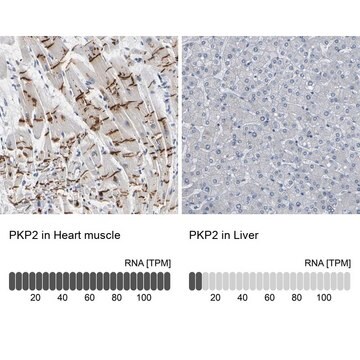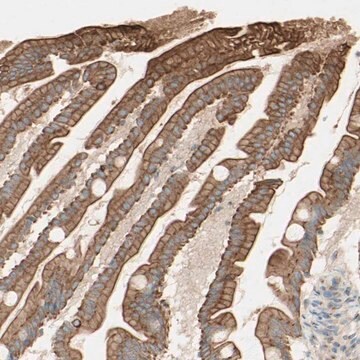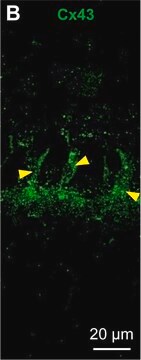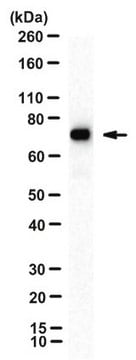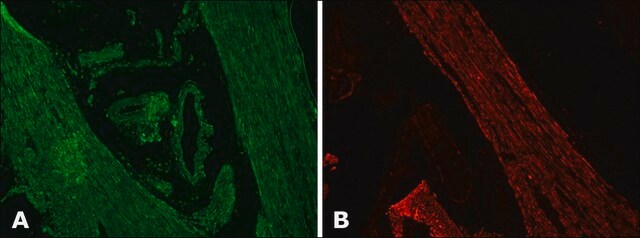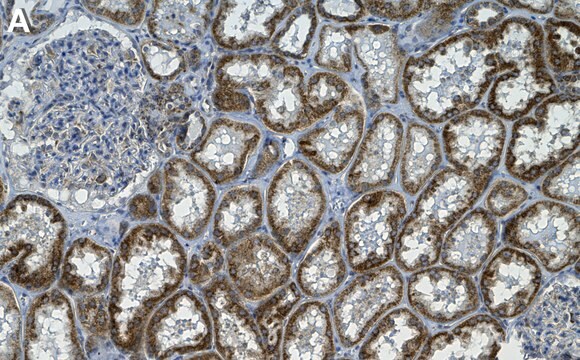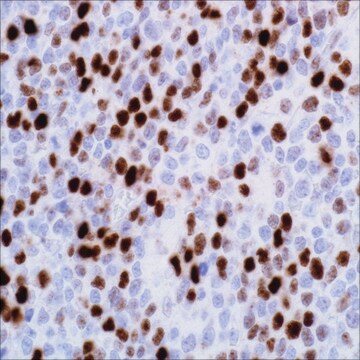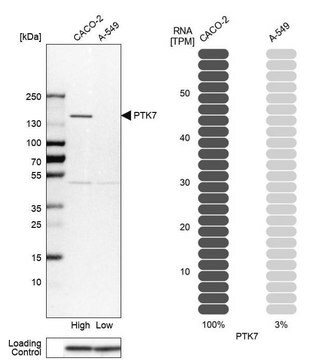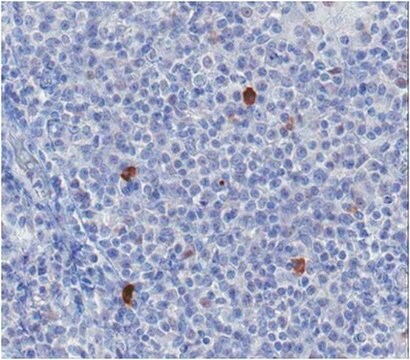推薦產品
生物源
rabbit
品質等級
共軛
unconjugated
抗體表格
affinity isolated antibody
抗體產品種類
primary antibodies
無性繁殖
polyclonal
產品線
Prestige Antibodies® Powered by Atlas Antibodies
形狀
buffered aqueous glycerol solution
物種活性
human
技術
immunofluorescence: 0.25-2 μg/mL
immunohistochemistry: 1:500-1:1000
免疫原序列
KFNVDGWTVYNPVEEYRRQGLPNHHWRITFINKCYELCDTYPALLVVPYRASDDDLRRVATFRSRNRIPVLSWIHPENKTVIVRCSQPLVGMSGKRNKDDEKYLDVIRETNKQISKLTIYDARPSVNAVANK
UniProt登錄號
運輸包裝
wet ice
儲存溫度
−20°C
目標翻譯後修改
unmodified
基因資訊
human ... MTM1(4534)
尋找類似的產品? 前往 產品比較指南
一般說明
MTM1 (myotubularin 1) is a lipid phosphatase, which is abundant at the junctional SR (sarcoplasmic reticulum) of the muscle triads. It is a member of conserved phosphatase family myotubularin, which contains both active phosphatases and inactive myotubularin-related proteins (MTMRs).
免疫原
Myotubularin recombinant protein epitope signature tag (PrEST)
應用
Anti-MTM1 antibody produced in rabbit, a Prestige Antibody, is developed and validated by the Human Protein Atlas (HPA) project . Each antibody is tested by immunohistochemistry against hundreds of normal and disease tissues. These images can be viewed on the Human Protein Atlas (HPA) site by clicking on the Image Gallery link. The antibodies are also tested using immunofluorescence and western blotting. To view these protocols and other useful information about Prestige Antibodies and the HPA, visit sigma.com/prestige.
Applications in which this antibody has been used successfully, and the associated peer-reviewed papers, are given below.
Immunofluorescence (1 paper)
Immunofluorescence (1 paper)
生化/生理作用
MTM1 (myotubularin 1) protein plays an essential role in facilitating the curvature of SR (sarcoplasmic reticulum) membrane and SR remodelling. Therefore, it is critical for homeostasis of calcium and excitation-contraction coupling. The major function of this protein is the dephosphorylation of phosphatidylinositol-3-phosphate (PtdIns3P) and phosphatidylinositol-3,5-bisphosphate (PtdIns(3,5P)2). Mutations in this gene are linked to X-linked myotubular myopathy (XLMTM), which is an inherited disorder characterized by severe generalized hypotonia and skeletal muscles weakness with respiratory insufficiency. Mostly this disease is fatal in the initial months of life. Heterozygous mutations resulting in abnormal splicing in this gene are associated with early onset, slowly progressive myopathy. c.431delT (p.Leu144fs) mutation in this gene results in bilateral subdural hygromas and cephalhaematomas in male twins suffering from severe myotubular myopathy.
特點和優勢
Prestige Antibodies® are highly characterized and extensively validated antibodies with the added benefit of all available characterization data for each target being accessible via the Human Protein Atlas portal linked just below the product name at the top of this page. The uniqueness and low cross-reactivity of the Prestige Antibodies® to other proteins are due to a thorough selection of antigen regions, affinity purification, and stringent selection. Prestige antigen controls are available for every corresponding Prestige Antibody and can be found in the linkage section.
Every Prestige Antibody is tested in the following ways:
Every Prestige Antibody is tested in the following ways:
- IHC tissue array of 44 normal human tissues and 20 of the most common cancer type tissues.
- Protein array of 364 human recombinant protein fragments.
聯結
Corresponding Antigen APREST74421
外觀
Solution in phosphate-buffered saline, pH 7.2, containing 40% glycerol and 0.02% sodium azide
法律資訊
Prestige Antibodies is a registered trademark of Merck KGaA, Darmstadt, Germany
免責聲明
Unless otherwise stated in our catalog or other company documentation accompanying the product(s), our products are intended for research use only and are not to be used for any other purpose, which includes but is not limited to, unauthorized commercial uses, in vitro diagnostic uses, ex vivo or in vivo therapeutic uses or any type of consumption or application to humans or animals.
未找到適合的產品?
試用我們的產品選擇工具.
儲存類別代碼
10 - Combustible liquids
水污染物質分類(WGK)
WGK 1
閃點(°F)
Not applicable
閃點(°C)
Not applicable
個人防護裝備
Eyeshields, Gloves, multi-purpose combination respirator cartridge (US)
Vandana A Gupta et al.
PLoS genetics, 9(6), e1003583-e1003583 (2013-07-03)
X-linked myotubular myopathy (XLMTM) is a congenital disorder caused by mutations of the myotubularin gene, MTM1. Myotubularin belongs to a large family of conserved lipid phosphatases that include both catalytically active and inactive myotubularin-related proteins (i.e., "MTMRs"). Biochemically, catalytically inactive
Jorge Oliveira et al.
European journal of human genetics : EJHG, 21(5), 540-549 (2012-09-13)
Myotubular myopathy (MIM#310400), the X-linked form of Centronuclear myopathy (CNM) is mainly characterized by neonatal hypotonia and inability to maintain unassisted respiration. The MTM1 gene, responsible for this disease, encodes myotubularin - a lipidic phosphatase involved in vesicle trafficking regulation
Ji Hyun Jeon et al.
Yonsei medical journal, 52(3), 547-550 (2011-04-14)
X-linked myotubular myopathy (XLMTM) is a rare congenital muscle disorder, caused by mutations in the MTM1 gene. Affected male infants present severe hypotonia, and generalized muscle weakness, and the disorder is most often complicated by respiratory failure. Herein, we describe
Valérie Tosch et al.
Neuromuscular disorders : NMD, 20(6), 375-381 (2010-05-04)
X-linked centronuclear myopathy (XLMTM), also called myotubular myopathy, is a severe congenital myopathy characterized by generalized hypotonia and weakness at birth and the typical histological finding of centralization of myo-nuclei. It is caused by mutations in the MTM1 gene encoding
Bilateral subdural hygromas and cephalhaematomas in male twins with severe myotubular myopathy caused by a Novel c.431delT (p.Leu144fs) mutation in MTM1 gene.
Tejasvi Chaudhari et al.
Journal of paediatrics and child health, 47(1-2), 64-65 (2010-05-27)
Global Trade Item Number
| 庫存單位 | GTIN |
|---|---|
| HPA010008-100UL | 4061836300586 |
我們的科學家團隊在所有研究領域都有豐富的經驗,包括生命科學、材料科學、化學合成、色譜、分析等.
聯絡技術服務